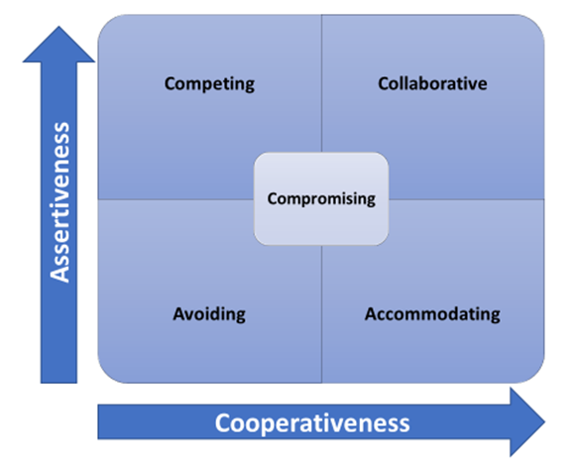There is no getting around it – conflict is everywhere, and the workplace is no exception. Some of our favorite television shows owe part of their grand appeal to the way they make light of situational workplace conflict (Think The Office or Parks and Recreation, for example). While often humorous for sitcom-binging viewers, poorly handled conflict in the real world is no laughing matter. Mismanaged conflict in the workplace is guaranteed to have detrimental and potentially long-lasting impacts on your organization, such as dysfunctional teamwork, increased employee turnover, and declines in workplace productivity.1 Fortunately, you as a leader have the influential power to manage conflict in an effective way, help your organization, and provide a valuable learning experience for the parties involved.

Think about the last conflict or disagreement you had with a colleague. This conflict could be minor or really emotionally charged. As you reflect on this conflict, how would you characterize your approach to managing the situation? The Thomas-Kilmann Conflict Mode Instrument (TKI) is a useful tool to identify your most common approach to conflict management based on a 15-item scale.2 Each approach in the model is labeled based on the level of assertiveness and cooperativeness that an individual engages in when managing conflict. As you read through the approaches, which one best fits you?
- Avoiding (Low Cooperativeness, Low Assertiveness) – Avoiding is characterized by an unwillingness to cooperate and a lack of assertiveness in achieving a goal. Perhaps there is an issue between you and an employee, and instead of actively attempting to confront the situation, you simply just let it be. This is generally not considered a healthy approach to managing conflict, as unmanaged problems almost always tend to get worse. While conflicts of the more frivolous variety may sometimes resolve themselves, the vast majority of conflicts need to be dealt with head on. A leader who lends themselves to an avoidant style of conflict management is likely to have an organization with ever-building tensions.
- Accommodating (High Cooperativeness, Low Assertiveness) – Accommodating is characterized by a strong willingness to work through conflict with another party, to the point that you may sacrifice something on your end. For example, an accommodating leader may give in to an employee’s demands for extra vacation time. If too accommodating, that leader may run the risk of feeling walked all over, all the while lowering their organization’s ceiling for productivity. On the positive side of things, accommodating leaders tend to mitigate the risk of damaging their relationships with others. In instances where you may wish to give the other party the benefit of the doubt regarding a tough situation, being accommodating could be the way to go.
- Competing (Low Cooperativeness, High Assertiveness) – The competing approach might be likened to a “win at all costs” mentality when it comes to conflict. Overly decisive leaders are likely to fall into this category. The competing style can be an especially effective approach for situations that call for immediate or drastic measures. If employed too often, however, leaders may garner a reputation in their employees’ eyes for being power hungry or unwilling to consider others’ opinions. A competing approach may be useful across a variety of workplace conflicts, but its near authoritarian nature may damage your relationships with other employees down the road if used out of moderation.
- Collaborating (High Cooperativeness, High Assertiveness) – Considered the most optimal approach of the bunch, the collaborating style strives to work through conflict without diminishing relationships or the goals of either party. A collaborating leader empowers all whom are involved to work together to find agreeable solutions that do not hurt anyone’s feelings. While this is clearly the most ideal way to manage conflict, it is also the most difficult to execute. The collaborative style requires a strong sense of psychological safety within the organization, meaning everyone feels comfortable to share their opinions and ideas without fear of blowback. A business or company that does not have a strong organizational culture will be unlikely to utilize this method effectively. Furthermore, the time it takes to sort through conflict collaboratively is often exhaustive compared to the aforementioned approaches.
- Compromising (Moderate Cooperativeness, Moderate Assertiveness) – Square in the middle of the other four approaches, the compromising style of conflict management seeks to please all parties, at least in part. When no obvious solution is present, a compromise may be the best option. Nobody may be completely happy with the outcome, but nobody is likely to be completely dissatisfied either. It also lends itself to the sharing of multiple perspectives, which can create an enhanced level of understanding and respect amongst employees that may not have existed prior to the compromise.
With the five conflict management styles in mind, how do you see yourself as a leader? Perhaps you envisioned yourself as one style, only to reflect on past experiences and realize you were in a completely different style. Maybe you have thought about ongoing conflicts within your organization and the approach that would best be suited to tackle each one. No matter your takeaway, there’s no disputing that managing conflict is a top priority for resilient and adaptable leaders. The way you intervene in every conflict is certain to have a ripple effect on your organization – do your best to ensure that it is a positive one.
If you would like to better yourself and your organization in terms of effective conflict management, reach out to us at HCS@HigherEchelon.com or through our website for more information.
Resources
- Isu, A. A. (2015). Conflicts in Organizations: Causes and Consequences. Journal of Educational Policy and Entrepreneurial Research, 2(11), 54-59. Retrieved December 19, 2018, from https://www.researchgate.net/publication/311558401_Conflict_in_Organizations_ Causes_and_Consequences.
- Thomas, K. W., & Kilmann, R. H. (1974, 2007). Thomas-Kilmann Conflict Mode Instrument. Mountain View, CA: CPP, Inc.